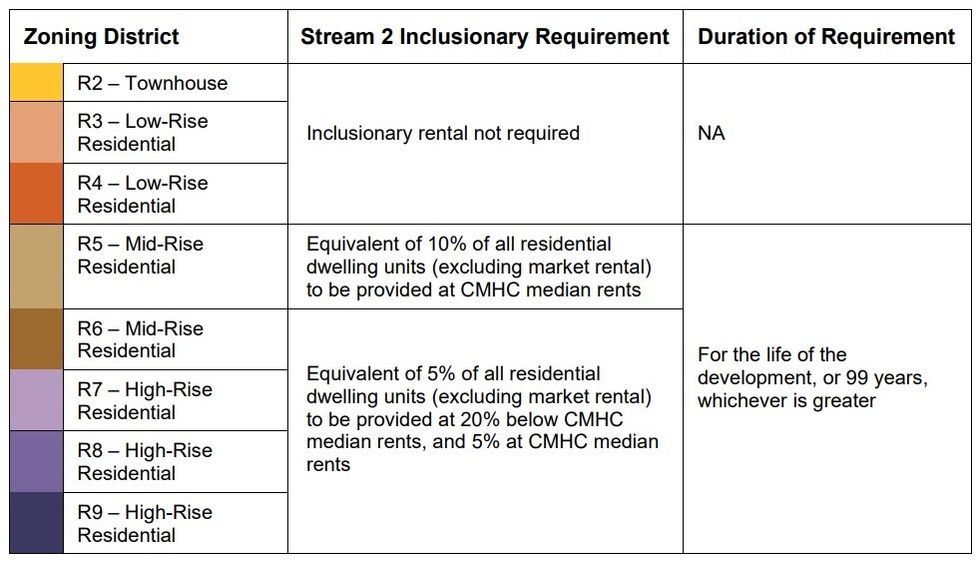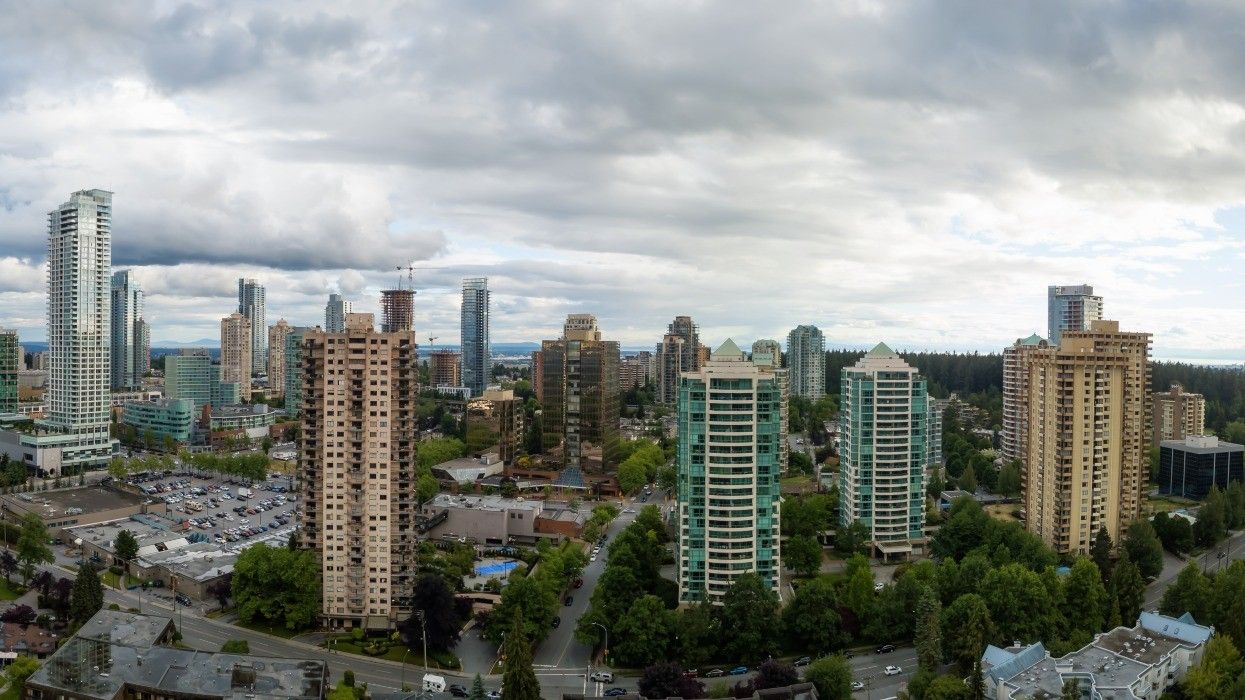Next week, in conjunction with a substantial change to its development framework, the City of Burnaby will be considering a suite of significant changes to its Rental Use Zoning Policy, which dictates the requirements for projects that involve rezoning and secures the provision of rental housing.
Adopted on March 9, 2020, the Rental Use Zoning Policy (RUZP) is structured into four "streams": replacement rental, inclusionary rental, voluntary rental, and protection of existing rental.
The City is currently considering a series of amendments to the inclusionary rental, as well as a change to the voluntary rental stream, with potential amendments to the other two streams in the future.
Excluding Rental Projects
Currently, the City of Burnaby requires new multi-family developments to include 20% of its total unit count as below-market rental units and this policy applies not just to strata projects, but also rental projects. As a result of this, standalone full-rental projects that aren't part of a multi-building project that includes strata units have been exceeding rare in Burnaby. (One of the rare ones that have been proposed in recent years just became the subject of foreclosure proceedings.)
The City is now proposing that this policy be amended to apply only to new strata developments.
"Exempting rental projects from the requirement to provide inclusionary rental units would likely encourage the supply of rental housing, helping to ease rent increases due to low vacancy rates," said City staff in a council report. "This approach is also necessary in order to provide a viable development path for many housing projects in those areas of the city with comparatively low unit sale values, which would otherwise be financially unviable or marginally viable if providing inclusionary housing were required."
20% to 10%
Additionally, the City is also proposing an amendment to reduce the requirement of 20% of total units to 10% of total units, excluding market rental units.
Unlike, as one example, the City of Vancouver, Burnaby's requirement is a percentage of the total units, rather than a percentage of the gross floor area, and Burnaby's 20% requirement is based on the base and bonus density, not the final density that includes offsets.
"When accounting for density offset and RMr density, the percentage of non-market rental units actually achieved is typically between 11-15% of total units within a residential development," said City staff. "However, it should be noted that this has only been observed in those areas of the city where developments that are subject to the RUZP requirements have proceeded, with other areas, such as Edmonds, having yet to see the completion of any inclusionary units."
The City conducted a thorough financial analysis of the RUZP — factoring in higher interest rates, development costs, and a 15% return-on-investment that's commonly required by lenders, among other things — and found that a reduction from 20% to 10% would support project viability while only seeing a "modest reduction" in units delivered, compared to the current policy.
A Range of Rental Rates
In exchange for improving project viability for developers, the City is proposing a change that would require the inclusionary rental units be provided at a mix of affordability levels.
Under the proposed change, half of the inclusionary rental units will be required to be provided at CMHC median rental rates and the remaining half at 20% below the CMHC median rates. As of the CMHC's October 2023 rental report, the CMHC median rental rate for North Burnaby, as one example, was $1,600, with 20% below that rate being $1,280.

The requirement will also vary depending on the scale of the project — another important factor that affects affordability. The new requirements would be tied to the updated zoning district schedule the City is considering concurrently with these changes.
"The financial analysis shows that the percentage of inclusionary rental units could be increased, but only if the affordability of the units is reduced commensurately," said City staff. "In determining the proposed percentage and rent rates, based on Burnaby's housing needs and other guiding policies such as the HOME Strategy, it is recommended that the City require a portion of units with deeper levels of affordability, with a diversity of rent levels to serve a broader cross section of the population."
Site Transfers and Cash-in-Lieu
In addition to the above, the City is also proposing a change that would allow the inclusionary rental obligation be transferred from the "generating site" — the subject site of the development — to another development site. This transfer would only be allowed if the other site is within the same CMHC rental zone, however, to ensure equivalent rental rates.
The City does currently allow this kind of transfer, as recently seen with the Pinnacle Lougheed and Carrigan Court projects by Pinnacle International, but on a case-by-case basis only. Permitting this by policy would provide a number of benefits to both developers, non-profit housing organizations, and Burnaby.
"For those sites that are marginal from a development financing perspective, the added flexibility of the location of the non-market housing may also contribute to the project’s viability, and whether the project proceeds," said staff. "The flexibility to transfer the obligation between CMHC zones with Council approval, creates an opportunity for staff to work with applicants when desirable, to encourage the delivery of non-market housing in areas of the City with the greatest need, where land values and development revenues are comparatively lower, resulting in fewer housing starts and a shortage of affordable housing options."
As another layer of flexibility, the City would also allow for cash payments in lieu of providing inclusionary rental units, a payment roughly equivalent to the capital costs the developer would have incurred by providing those units, and the City would then use this capital to deliver non-market housing in areas with the most need. (Perhaps through the Burnaby Housing Authority.)
Other Amendments
Under current policies, development projects that involve the redevelopment of existing purpose-built rental housing are required to provide either a 1:1 replacement of all the existing units or 20% of the total units in the new development as inclusionary rental units, whichver is greater.
The City is now proposing to "decouple" replacement units from inclusionary units.
"Based on preliminary analysis of Burnaby’s current replacement rental policy, it is estimated that sites redeveloping existing rental stock typically require a minimum of 5 to 6 times the amount of density that currently exists on the site, to make the proforma work," said staff. "Such a density increase is not contemplated nor appropriate for all sites with existing rental housing."
The City is currently undertaking a review of its tenant protection policies and says that review will inform how it proceeds with this proposed change.
Lastly, the City is also considering height relaxations where voluntary non-market rental units are proposed and also proposing to, essentially, remove Stream 3 under the RUZP, because it would "no longer be relevant or applicable" under the new height-based development framework.
On Monday, October 7, City staff will be seeking the greenlight from Council to proceed with the aforementioned changes. If greenlit, staff will then work on bringing forth the necessary amendments, which will then be presented and considered by Council at a later date.





















